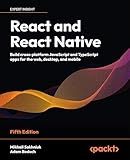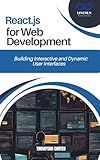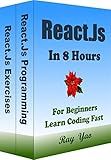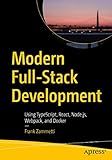Best Tools to Handle Query Params in React.js to Buy in November 2025

The Road to React: Your journey to master plain yet pragmatic React.js



React and React Native: Build cross-platform JavaScript and TypeScript apps for the web, desktop, and mobile



React JS: A Step-by-Step Guide to Mastering the Top Web Development Library from Basic to Advanced Level (Coding Made Easy)



REACT.JS FOR WEB DEVELOPMENT: Building Interactive and Dynamic User Interfaces



Mastering React JS From Development to Deployment: Become React JS Expert



The Complete Guide to Web Development with React AND Node.js: Techniques for Fast, Scalable, and Secure Apps.



React JS Machine Coding Projects: Learn 31 Real World Machine Coding Projects and 50 Must-Know Interview Questions, from Basics to Advanced



React.Js Programming, In 8 Hours, For Beginners, Learn Coding Fast: React.Js Language, Crash Course Textbook & Exercises (Textbooks in 8 Hours 14)



Modern Full-Stack Development: Using TypeScript, React, Node.js, Webpack, and Docker



D3.js in Action, Third Edition


To get query parameters in React.js, you can make use of the URLSearchParams API which is built-in in modern browsers. Here's an example:
- Import the useEffect hook and useLocation hook from the react-router-dom package:
import { useEffect } from "react"; import { useLocation } from "react-router-dom";
- Create a functional component and use the useEffect and useLocation hooks:
function MyComponent() { const location = useLocation();
useEffect(() => { const queryParams = new URLSearchParams(location.search); const param1 = queryParams.get("param1"); const param2 = queryParams.get("param2");
console.log(param1, param2);
}, [location]);
// Rest of your component code }
- In the useEffect hook, location.search contains the query parameters from the URL. We create a new instance of URLSearchParams using location.search.
- Use the get method on URLSearchParams to retrieve specific query parameters. In this example, param1 and param2 are the names of the query parameters we want to retrieve.
- Finally, you can use the query parameters in your component as desired. In the example, we are logging the values to the console.
This approach allows you to access and utilize the query parameters in your React components.
How to pass query params in a React.js redirect?
In React.js, you can pass query parameters in a redirect by using the react-router-dom library. Here's an example of how you can achieve this:
- Install the react-router-dom library using npm:
npm install react-router-dom
- Import the necessary components from react-router-dom:
import { BrowserRouter as Router, Route, Redirect } from 'react-router-dom';
- Create a component that handles the redirection and passes the query parameters:
const RedirectComponent = () => { return ; };
In this example, the redirect is set to the /destination page with two query parameters: param1=value1 and param2=value2.
- Set up the routing in your main component:
const App = () => { return ( ); };
Here, the RedirectComponent is mapped to the /redirect path, and the DestinationComponent is mapped to the /destination path.
- Create the component that will receive the query parameters:
const DestinationComponent = (props) => { const searchParams = new URLSearchParams(props.location.search); const param1 = searchParams.get('param1'); const param2 = searchParams.get('param2');
return ( Destination Page param1: {param1} param2: {param2} ); };
In this component, we retrieve the query parameters using props.location.search and then use the URLSearchParams API to parse the query string. Finally, we can access the individual query parameters using the get() method.
Now, when you navigate to /redirect, you will be redirected to /destination with the query parameters param1=value1 and param2=value2, and those values will be displayed on the destination page.
What are the security implications of using query params in React.js?
Using query params in React.js can have the following security implications:
- Information Leakage: Query parameters are visible in the browser's address bar and can potentially expose sensitive information. This can include user credentials or other confidential data.
- Cross-Site Scripting (XSS): If query parameters are not properly validated or sanitized before being used in dynamic content rendering, it can lead to XSS vulnerabilities. Attackers may inject malicious scripts through query params that can be executed by unsuspecting users.
- Injection Attacks: Crafting malicious URLs with specific query parameters can potentially exploit vulnerabilities in server-side code if the parameters are not properly validated or sanitized. Injection attacks, such as SQL or command injections, can occur if the data from query params is used in database queries or system commands without proper validation or parameterization.
- Open Redirects: If query params are used for redirecting users to different URLs, improper validation can allow attackers to craft malicious URLs that redirect users to phishing or malware-infected websites.
To mitigate these security implications, it is important to validate and sanitize query parameters on the server-side before using them in any sensitive operations. Additionally, proper input validation and output encoding techniques should be employed to prevent XSS attacks.
What is the impact of query params on React.js component reusability?
Query params do not have any direct impact on the reusability of React.js components.
React components are designed to be reusable and independent of the data that they receive. Components should be able to render correctly based on the data that is passed to them as props, including query params.
When using query params in a React.js application, the components should be designed in such a way that they can handle the changes in query params and update their rendering accordingly. This can be achieved by using the useEffect hook to listen to changes in query params and update the component state or props accordingly.
By designing components in a reusable manner, they can be easily used in different parts of the application, regardless of whether query params are used or not. The reusability of React components is primarily determined by their design, structure, and separation of concerns, rather than the presence of query params.
How to handle query params when using React.js server-side rendering?
There are a few ways to handle query parameters when using server-side rendering in React.js:
- Using React Router: If you are using React Router, you can handle query parameters by configuring your routes to accept query parameters. React Router will automatically parse the query parameters and pass them as props to your React components.
- Manual parsing: If you are not using React Router or need more granular control over query parameter handling, you can manually parse the query parameters on the server-side. You can use the built-in querystring module in Node.js to parse the query parameters from the URL.
Here's an example of how you can manually parse query parameters:
const queryString = require('querystring'); const url = require('url');
// ...
const parsedUrl = url.parse(req.url); const queryParams = queryString.parse(parsedUrl.query);
// Now you have access to the query parameters in the `queryParams` variable
You can then pass the query parameters as props to your React component when rendering it on the server.
- Query parameter libraries: There are also libraries available that can help you handle query parameters in a more convenient way, such as qs or query-string. These libraries provide helper functions for parsing and stringifying query parameters.
Regardless of the method you choose, it's important to handle query parameters securely to prevent any potential security vulnerabilities, such as SQL injection or XSS attacks. Make sure to sanitize and validate any user input that comes from query parameters before using it in your application.
How to handle query param changes in React.js?
In React.js, you can handle query param changes using the "useEffect" hook and the "useLocation" hook from the react-router-dom package. Here are the steps involved:
- Import the necessary hooks:
import { useEffect } from 'react'; import { useLocation } from 'react-router-dom';
- Inside your component, create a variable to store the current location:
const location = useLocation();
- Use the "useEffect" hook to listen for changes in the query parameters:
useEffect(() => { // Your code to handle query param changes }, [location.search]);
The effect will be triggered whenever the "search" property of the location object changes, which represents the query parameters.
- Within the useEffect callback function, you can access the updated query parameters using "location.search". You can parse and manipulate the query string using libraries like "qs" or "URLSearchParams".
Here's an example of how you can update the component state when the query parameters change:
useEffect(() => { const searchParams = new URLSearchParams(location.search); const paramValue = searchParams.get('paramName'); // Update state or perform any other actions based on the new query param value }, [location.search]);
Remember to pass the query parameters as part of the URL or using the "history.push" method to trigger the query param changes.
By using these hooks, you can easily handle query parameter changes and update your app's state or perform any necessary actions accordingly.
How to test/query params functionality in React.js components?
There are several ways to test/query params functionality in React.js components. Here are a few common approaches:
- Use the React Router testing library: If your React.js component is using React Router to handle routing and query params, you can use the React Router testing library. This library provides utility functions to test your React Router components and access/query the query params. You can use functions like render, screen, and within to access the rendered component and query the query params.
- Pass query params as props and test the component: If your React.js component receives query params as props, you can simply pass the query params as props while testing and assert the expected behavior based on those props. For example, you can create a test case where you pass different query params and check if the component renders correctly with the expected data.
- Use a mocking library: If you are making API requests based on query params in your React.js component, you can use a mocking library like msw (Mock Service Worker) or axios-mock-adapter to mock the API responses. By configuring the mock to return different responses based on different query params, you can effectively test the query params functionality in your component.
- Manipulate the URL manually: In some cases, you can manually manipulate the URL in your test environment to simulate different query params. You can use JavaScript methods like window.history.pushState() to modify the URL in your test case, and then check if the component reacts correctly to the updated query params.
Remember to write test cases covering different scenarios to ensure comprehensive test coverage for your query params functionality.
What is the syntax for accessing query params in React.js?
In React.js, you can access query parameters using the react-router-dom library.
Here's an example of how you can access query parameters in React.js:
- Install the react-router-dom library by running the following command:
npm install react-router-dom
- Create a component with a route that accepts query parameters. For example, you can define a route in your App.js file:
import { BrowserRouter as Router, Route, Switch } from 'react-router-dom'; import MyComponent from './MyComponent';
function App() { return ( ); }
- In your MyComponent.js file, you can access the query parameters by using the useLocation hook from react-router-dom:
import { useLocation } from 'react-router-dom';
function MyComponent() { const location = useLocation(); const queryParams = new URLSearchParams(location.search);
// Access individual query parameters const param1 = queryParams.get('param1'); const param2 = queryParams.get('param2');
// Use the query parameters in your component // ...
return ( {/* Render your component */} ); }
In this example, say you navigate to /my-component?param1=value1¶m2=value2, you can access the query parameters param1 and param2 within the MyComponent component using queryParams.get('param1') and queryParams.get('param2') respectively.
What is the performance impact of using query params in React.js?
The performance impact of using query params in React.js depends on several factors including the size and complexity of the query params, how they are used within the application, and the overall performance optimization techniques implemented in the React.js application.
Using query params can increase the complexity of the component's rendering logic, as it may need to extract and parse the query params for certain functionality. This additional logic can impact the render time of the component, especially if the query params are used extensively.
However, React.js is designed to efficiently update and render components based on changes in props and state. If the component is properly optimized, the performance impact of using query params might be negligible. React's virtual DOM diffing algorithm helps optimize rendering by only updating the necessary parts of the UI.
To mitigate or minimize any performance impact, it is recommended to:
- Throttle or debounce the handling of query param updates to prevent excessive re-renders.
- Use memoization techniques like React.memo or useMemo to memoize expensive computations when dealing with query params.
- Avoid deeply nested components that unnecessarily re-render when the query params change. Use React's shouldComponentUpdate or React.memo to prevent re-rendering if the relevant query params aren't updated.
- Leverage React Router's built-in routing capabilities for handling and managing query params, as it provides optimized routing for React applications.
In summary, the performance impact of using query params in React.js can vary based on different factors, but with proper optimization techniques, the impact can be minimized.
What are some common use cases for query params in React.js?
Some common use cases for query params in React.js include:
- Filtering and Sorting: You can use query params to pass sorting and filtering options to the server and update the component's state based on the query params. This allows users to sort and filter data without reloading the page.
- Pagination: Query params can be used to specify the current page or the number of items to display per page, allowing users to navigate through paginated data.
- Sharing State: Query params can be used to share the state of a component or a view. For example, you can use query params to share the current selected tab, a specific list of items, or the current view mode between different users or when sharing a link.
- Search: Query params can be used to pass search queries to the server and update the UI accordingly. The component can fetch and display search results based on the query params.
- Tracking and Analytics: Query params can be used to pass tracking or analytics information. For example, you can append query params to track the source or medium of a user visiting a specific page.
These are just a few examples, and query params can be used in a variety of ways depending on your specific application requirements.
